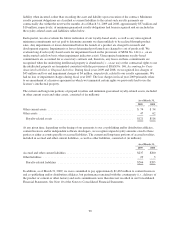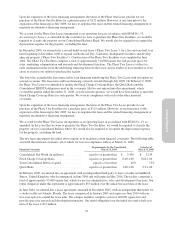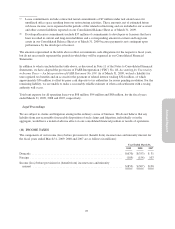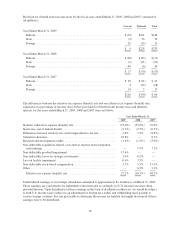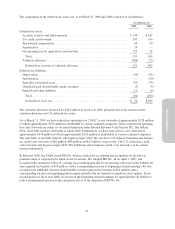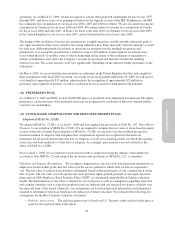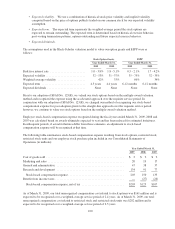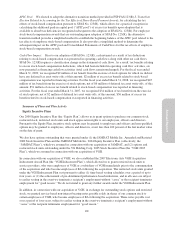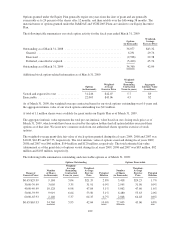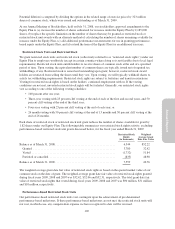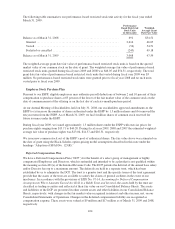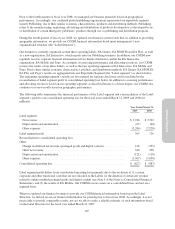Electronic Arts 2009 Annual Report Download - page 179
Download and view the complete annual report
Please find page 179 of the 2009 Electronic Arts annual report below. You can navigate through the pages in the report by either clicking on the pages listed below, or by using the keyword search tool below to find specific information within the annual report.
Annual Report
operations. As of March 31, 2009, we had not agreed to certain other proposed adjustments for fiscal years 1997
through 2005, and those issues were pending resolution by the Appeals section of the IRS. Furthermore, the IRS
has commenced an examination of our fiscal year 2006, 2007 and 2008 tax returns. We are also under income tax
examination in Canada for fiscal years 2004 and 2005. We remain subject to income tax examination in Canada
for fiscal years 2000 and after 2001, in France for fiscal years after 2005, in Germany for fiscal years after 2003,
in the United Kingdom for fiscal years after 2007, and in Switzerland for fiscal years after 2006.
The timing of the resolution of income tax examinations is highly uncertain, and the amounts ultimately paid, if
any, upon resolution of the issues raised by the taxing authorities may differ materially from the amounts accrued
for each year. Although potential resolution of uncertain tax positions involve multiple tax periods and
jurisdictions, it is reasonably possible that a reduction of up to $70 million of unrecognized tax benefits may
occur within the next 12 months, some of which, depending on the nature of the settlement or expiration of
statutes of limitations, may affect the Company’s income tax provision and therefore benefit the resulting
effective tax rate. The actual amount could vary significantly depending on the ultimate timing and nature of any
settlements.
On May 6, 2009, we received notification from the tax authorities in the United Kingdom that they had completed
their examination of the fiscal 2005 tax return. As a result, in our fiscal quarter ended June 30, 2009, we will record
a tax benefit of approximately $33 million, which includes the recognition of approximately $21 million in
previously unrecognized tax benefits, as well as a reduction in our accrual for related interest and penalties.
(12) PREFERRED STOCK
As of March 31, 2009 and 2008, we had 10,000,000 shares of preferred stock authorized but unissued. The rights,
preferences, and restrictions of the preferred stock may be designated by our Board of Directors without further
action by our stockholders.
(13) STOCK-BASED COMPENSATION AND EMPLOYEE BENEFIT PLANS
Adoption of SFAS No. 123(R)
We adopted SFAS No. 123(R), as of April 1, 2006 and have applied the provisions of SAB No. 107, Share-Based
Payment, to our adoption of SFAS No. 123(R). We are required to estimate the fair value of share-based payment
awards on the date of grant. Upon adoption of SFAS No. 123(R), we elected to use the modified prospective
transition method of adoption which requires that compensation expense be recognized in the financial
statements for all awards granted after the date of adoption, as well as for existing awards for which the requisite
service has not been rendered as of the date of adoption. Accordingly, prior periods were not restated for the
effect of SFAS No. 123(R).
Prior to April 1, 2006, we accounted for stock-based awards to employees using the intrinsic value method in
accordance with APB No. 25 and adopted the disclosure-only provisions of SFAS No. 123, as amended.
Valuation and Expense Recognition. We recognize compensation costs for stock-based payment transactions to
employees based on their grant-date fair value over the service period for which such awards are expected to
vest. The fair value of restricted stock units is determined based on the quoted price of our common stock on the
date of grant. The fair value of stock options and stock purchase rights granted pursuant to our equity incentive
plans and our 2000 Employee Stock Purchase Plan (“ESPP”) is determined using the Black-Scholes valuation
model. The determination of fair value is affected by our stock price as well as assumptions regarding subjective
and complex variables such as expected employee exercise behavior and our expected stock price volatility over
the expected term of the award. Generally, our assumptions are based on historical information and judgment is
required to determine if historical trends may be indicators of future outcomes. We estimated the following key
assumptions for the Black-Scholes valuation calculation:
•Risk-free interest rate. The risk-free interest rate is based on U.S. Treasury yields in effect at the time of
grant for the expected term of the option.
99



